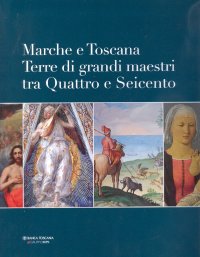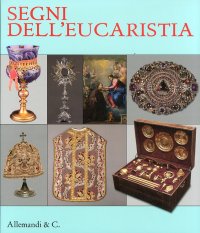Beato Angelico
Firenze, Palazzo Strozzi, September 26, 2025 - January 25, 2026.
Edited by Carl Brandon Strehlke.
Testi di Stefano Casciu, Marco Mozzo, Angelo Tartuferi.
Venezia, 2025; bound, pp. 456, 300 col. ill., cm 24x29.
cover price: € 80.00
|
Books included in the offer:
Beato Angelico
Firenze, Palazzo Strozzi, September 26, 2025 - January 25, 2026.
Edited by Carl Brandon Strehlke.
Testi di Stefano Casciu, Marco Mozzo, Angelo Tartuferi.
Venezia, 2025; bound, pp. 456, 300 col. ill., cm 24x29.
FREE (cover price: € 80.00)
Marche e Toscana. Terre di grandi maestri tra Quattro e Seicento
Ospedaletto, 2007; bound, pp. 320, col. ill., col. plates, cm 25,5x29.
FREE (cover price: € 77.00)
Segni dell'Eucarestia
Edited by M. Luisa Polichetti.
Ancona, Osimo, Loreto Jesi, Senigallia, Fabriano e Metelica, 23 giugno - 31 ottobre 2011.
Torino, 2011; paperback, pp. 221, b/w and col. ill., cm 24x28.
FREE (cover price: € 32.00)
Giorgio De Chirico. Catalogo Generale. Opere dal 1912 al 1976. Catalogue of Works 1912-1976. Volume I
Maretti Editore
Edited by Fondazione Giorgio e Isa de Chirico.
Translation by Noel-Johnson V. and Robinson K.
Saggio introduttivo di Claudio Strinati.
Italian and English Text.
Falciano, 2014; silk bound in a case, pp. 468, col. ill., cm 24x28.
series: Giorgio De Chirico. Catalogo Generale
ISBN: 88-98855-09-5 - EAN13: 9788898855094
Subject: Essays (Art or Architecture),Graphic Arts (Prints, Drawings, Engravings, Miniatures),Monographs (Painting and Drawing),Monographs (Sculpture and Decorative Arts)
Period: 1800-1960 (XIX-XX) Modern Period,1960- Contemporary Period
Languages: 

Weight: 2.77 kg
Published by Maretti Editore, the present volume includes paintings and works on paper authenticated over the years by the Foundation, which has duly catalogued and dated each artwork. The works reproduced here in were not included in Claudio Bruni Sakraischik's original Catalogo generale di Giorgio de Chirico (1971-1987). The selection of works, many of which are little-known or totally unknown, makes a substantial contribution to knowledge on the artist's oeuvre.
The present volume is the result of complex and in-depth study carried out by the Foundation's Authentication Committee (involving documentary source research, technical analysis as well as the study of the artist's iconographic subject matter and different stylistic periods). The identification of authentic works by the artist constitutes one of the Foundation's principal objectives in its endeavour to safeguard Giorgio de Chirico's art and intellectual work.
Unexpected elements of de Chirico's multifaceted oeuvre come to light in the material published here for the first time.
Furthermore, this new series is intended as a valid research tool, offering dechirichan enthusiasts, scholars and experts alike, the possibility of consulting and comparing a significant amount of the artist's work (reproduced in colour and black and white). The divulgation of such a large number of works, many of which are completely unknown or have remained until now outside the realm of academic research, will undoubtedly play an important role in the advancement of the study of Giorgio de Chirico's art.
The 468-page catalogue includes an introductory essay by Claudio Strinati, a foreword by Paolo Picozza, President of Fondazione Giorgio e Isa de Chirico, a brief biography on the artist and a summary of the Foundation's activity.
The second volume of the series is planned to be released in late 2014.
Biography
1888-1905 Giuseppe Maria Alberto Giorgio de Chirico was born on 10 July 1888 in Volos, Greece. His father, Evaristo de Chirico, from a noble family of Sicilian origin, worked as a railway engineer on the construction of the Thessaly railway. His mother, Gemma Cervetto, was a noblewoman from Genoa. In 1891, his elder sister Adelaide died. In August 1891, his brother Andrea (who changed his name to Alberto Savinio in 1914) was born in Athens where the de Chirico family had temporarily moved. In 1896, the family returned to Volos where they stayed until 1899 and where Giorgio took his first drawing lessons. They then returned to Athens, where Giorgio attended the Athens Polytechnic from 1903-1906. After several years of ill health, Giorgio's father died in May 1905 at age 62.
Giorgio de Chirico, ca 1907
1906-1909 In September 1906, his mother decided to leave Greece. After two short stopovers in Venice and Milan the family moved to Munich where Giorgio attended the Academy of Fine Arts whilst Andrea studied music. Giorgio studied the art of Arnold Böcklin and Max Klinger, and read the works of Nietzsche, Schopenhauer and Weininger with great interest. In June 1909, he joined his mother and brother in Milan, where they had recently moved.
1910-1915 In March 1910, de Chirico moved to Florence where Brunelleschi's architecture made a strong impression upon him and where he recommenced his study of Nietzsche with fervour. He began to paint subjects in which he attempted to express the strong and mysterious feeling he had discovered in Nietzsche's writings: "the melancholy of beautiful autumn afternoon in Italian cities". He painted his first metaphysical painting entitled The Enigma of an Autumn Afternoon, inspired by a vision he had in Piazza Santa Croce, which was also influenced by Giotto's fresco in the Bardi family chapel of the Basilica of Santa Croce. Prior to this painting, he executed The Enigma of the Oracle and later, while still in Florence in 1910, The Enigma of the Hour and the famous Self-portrait inscribed with the Nietszchean epigraph "Et quid amabo nisi quod aenigma est?".
In July 1911, Giorgio and his mother stopped in Turin on their way to join Andrea in Paris. Elements of the city's architecture would become iconographic themes in his famous Italian Piazza paintings. In the autumn of 1912, he showed his work for the first time at the Salon d'Automne held at Grand Palais. In March 1913, he exhibited three paintings at Salon des Indépendants. Picasso and Apollinaire took notice of his work. Apollinaire, who greatly appreciated his paintings, wrote a review in "L'Intransigeant" on the exhibition the artist held in his studio in October. The two would begin collaboration in January 1914. Through Apollinaire he met Ardengo Soffici, as well as Constantin Brancusi, Max Jacob, André Derain and Georges Braque. De Chirico introduced his brother Savinio to Apollinaire at the end of January. The two attended "Les Soirées de Paris" encounters together. He met Paul Guillaume, his first art dealer. He exhibited again at the Salon des Indépendants in the spring of 1914. Ardengo Soffici wrote about the de Chirico brothers in the magazine "Lacerba". He began work on the mannequin theme. He painted his famous portrait of Apollinaire and gave it to him; the following year the poet dedicated the poem Océan de Terre to him.
1915-1918 In May 1915, de Chirico and Savinio returned to Italy to report to the military authorities and were sent on to Ferrara. De Chirico, assigned a non-combat position, remained in Ferrara where he painted the first works on the Metaphysical Interior theme: "What struck me above-all and inspired me from the metaphysical point of view in which I was working at the time, were certain elements of Ferrarese interiors, certain windows, certain workshops, certain homes, certain districts, like the old ghetto, where one found sweets and biscuits in extremely metaphysical and strange shapes." During the same period, he painted The Great Metaphysician, Hector and Andromaca, The Troubadour and The Disquieting Muses. In 1916 he met Filippo de Pisis (who was just twenty years old at the time). In 1917 he spent a few months at the Villa del Seminario army hospital for nervous disorders where Carlo Carrà was also recovered. What would later be called the "School of Metaphysical Art" came into being. He came into contact with the Dada circle of Tristan Tzara and the magazine "Dada 2". At the end of the year he moved to Rome with his mother where he published the essay Zeusi l'esploratore (Zeusi the Explorer) in the first issue of "Valori Plastici", dedicating it to the magazine's founder, Mario Broglio. In the essay he proclaimed: "It is necessary to discover the demon in all things... It is necessary to discover the eye in all things... We are explorers ready for new departures."
1919-1924 In February 1919, de Chirico held his first one-man show in Rome at Casa d'Arte Bragaglia. On this occasion his essay entitled Noi Metafisici (We Metaphysicians) was published in "Cronache d'attualità". In the essay he wrote: "Schopenhaur and Nietzsche were the first to teach the profound importance of the non-sense of life and how such non-sense can be transferred to Art... The good and new craftsmen are philosophers who have surpassed philosophy". During this period, he rediscovered the Museum and started to make copies of paintings by the Great Masters of the Italian Renaissance. He went to Florence and studied the techniques of tempera and panel painting. In 1921, a one-man show was held in Milan at Galleria "Arte". The same year he began corresponding with André Breton. He published articles on Böcklin, Klinger, Menzel, Thoma, Renoir and Raphael in a number of magazines. In 1922, an important exhibition was held at Galerie Paul Guillaume in Paris with fifty-five works exhibited. Breton wrote the introduction to the catalogue. In 1923, Paul Éluard and his wife Gala visited de Chirico whilst in Rome for the Roman Biennial and purchased several of his paintings. It was through this friendship that de Chirico met Max Ernst, who painted his portrait with representatives of the imminent Surrealist movement in Au Rendez-vous des amis. In 1924 he collaborated with the Roman periodical "La Bilancia". He participated in the XIV Venice Biennial. The same year he met his future wife, the Russian ballerina Raissa Gourevitch Krol, in Rome. He went to Paris with Raissa where he designed the theatrical sets and costumes for Pirandello's The Jar with music by Alfredo Casella for the Swedish Ballet Company at the Théâtre des Champs-Élysées. He collaborated on the first issue of "La Révolution Surréaliste" and was immortalised by Man Ray in his famous group portrait.
1925-1929 He began a period in which he explored the themes of the Metaphysics of Light as well as Mediterranean Myth, creating works such as the Archaeologists, Horses by the Seashore, Trophies, Landscapes in a Room, Furniture in the Valley and the Gladiators. Following the opening of a solo show at Léonce Rosenberg's gallery, the Surrealists heavily criticised his most recent work. His break-up with the Surrealists was now conclusive and destined to only worsen in the years to follow. It is at this time that de Chirico made the acquaintance of Albert C. Barnes, who would become a great supporter and collector of his works. In 1928, Jean Cocteau's monograph Le Mystère Laïc - Essai d'étude indirecte (The lay mystery - an essay of indirect study) was published with lithographs by the artist, and in Milan, Piccolo Trattato di Tecnica Pittorica (Small treatise on painting technique), was published by Scheiwiller. In 1929, Pierre Levy's Éditions du Carrefour published Hebdomeros, le peintre et son génie chez l'écrivain (Hebdomeros - the painter and his genius in the writer). He designed the costumes for the ballet Le Bal, produced by Serge Diaghilev's Ballets Russes (Montecarlo, Paris, London). In the meantime, he exhibited with the Novecento group in Italy (Milan) and abroad (Zurich and Amsterdam) and also in England, Germany and the United States.
1930-1935 He married Raissa on 3 February 1930. Gaillmard published Apollinaire's Calligrammes illustrated with sixty-six lithographs by the artist. In the autumn, he met Isabella Pakszwer (later known as Isabella Far) who would become his second wife and remain his life-long companion. At the end of 1931, his marriage to Raissa, in difficulty for some time, ended in separation. He left Paris with Isabella and moved to Florence. During these years, he painted still-lifes, portraits and female nudes of a luminous naturalism. He exhibited at the XVIII Venice Biennial in the gallery dedicated to the Italian artists in Paris. In 1933 he participated in Milan's V Triennial for which he painted the monumental fresco La cultura italiana. He continued his work for the theatre: designing the scenes and costumes for The Puritans by V. Bellini for I Maggio Musicale Fiorentino (1933); the scenery for D'Annunzio's Jorio's Daughter directed by Pirandello at Rome's Teatro Argentina. He returned to Paris with Isabella where he studied historic treaties on painting technique. In 1934, he illustrated Cocteau's Mythologie with ten lithographs on the Mysterious Baths theme.
1936-1937 He went to New York in 1936 where he exhibited at the Julien Levy Gallery. A significant number of works were bought by Albert C. Barnes for his museum and by other art collectors. De Chirico collaborated with magazines such as "Vogue" and "Harper's Bazaar". He also executed a mural entitled Petronius and a Modern-day Adonis in Tails for the Scheiner tailor's shop and decorated a wall at Helena Rubinstein's beauty institute. Furthermore, he executed a work, as did Picasso and Matisse, for the Decorators Pictures Gallery's drawing room. In June 1937, he received news from his brother of their mother's death.
1938-1947 In January 1938 he returned to Italy and settled in Milan, to then leave for Paris, as he was disgusted by the racial laws enacted Italy. He exhibited in Rome's III Quadrennial d'Arte Nazionale. In Florence during the war, he began creating terracotta sculptures: the Archaeologists, Hector and Andromaca, Hippolytus and his Horse and a Pietà. He published Il Signor Dudron in "Prospettive" and an essay on sculpture Brevis Pro Plastica Oratio in "Aria d'Italia". In 1941, the American art critic and collector James Thrall Soby published The Early Chirico. He wrote a number of art theory articles for various periodicals, which were later reunited in La commedia dell'arte moderna (Rome 1945). In 1944 he settled permanently in Rome. Irving Penn photographed the artist with a laurel crown in a celebrative and ironic pose. He designed the scenery for Don Giovanni, a ballet with music by R. Strauss, choreographed by A. Milloss for the Rome Opera. In 1945 he published the autobiographical books: The Memoirs of Giorgio de Chirico and 1918-1925 - Ricordi di Roma (Recollections of Rome). His research on the Old Masters intensified with a number of copies from Rubens, Delacroix, Titian, Watteau, Fragonard and Courbet. Many exhibitions of the artist's work were held after the Second World War. He began a fierce battle against the falsification of his works, a phenomenon inspired by the Surrealists as early as the 1920s. On 18 May 1946, he married Isabella Pakszwer. In June 1946, the Parisian Galerie Allard put on, with Breton's approval, a de Chirico show in which twenty-four fake metaphysical works painted by the Surrealist painter Oscar Dominquez were exhibited. During the course of 1947, he moved his studio to n. 31 Piazza di Spagna and the following year made this his permanent residence, where he would live until the end of his life.
1948-1959 At the end of 1948, he was elected an honorary member of the Royal Society of British Artists. In 1949, he was invited to hold a one-man show at the society's prestigious headquarters. In 1950, in protest of the Venice Biennial where a "formidable fake" de Chirico (painted by the Surrealist Oscar Dominquez) had been exhibited two years earlier and the prize for Metaphysical Painting had been awarded Giorgio Morandi, he organised an Anti-Biennial exhibiting with other "anti-modern" artists at Venice's Bucintoro Rowing Club. Similar shows took place in 1952 and 1954. On 5 May 1952, Alberto Savinio died in Rome. De Chirico continued his research on Baroque painting, executing various copies from Rubens. He continued to exhibit frequently within Italy and abroad. He kept up his battle against Modern Art.
1960-1969 He dedicated himself to producing lithographs and illustrated Manzoni's The Betrothed in 1965 and Quasimodo's translation of The Iliad in 1968. He began revisiting earlier subject matter with particular focus on the use of colour, thus beginning a period of research known as Neometaphysics. Towards the end of the 1960s, he began to cast bronze sculptures. Later on, he created sculptures in silver patina or gilded bronze and jewellery-sculptures in silver or gilded silver.
1970-1978 In 1970 in Milan, Palazzo Reale held an important retrospective of the artist's work. A significant exhibition was also held in Ferrara at Palazzo dei Diamanti. In 1971, Claudio Bruni Sakraischik began publishing Catalogue Generale - Giorgio de Chirico (Catalogue raisonne of Giorgio de Chirico's work). In 1972, he received the Ibico Reggino Prize. In 1973, de Chirico created the Mysterious Baths Fountain in Milan's Sempione park near Palazzo dell'Arte for the XV Triennial of Milan. In 1974, he was elected to the Academy of France. On 20 November 1978, Giorgio de Chirico died in Rome at 90 years of age. In 1992, his remains were transferred to the San Francesco a Ripa church in the Trastevere quarter of Rome.
(http://www.fondazionedechirico.org/biografia)











